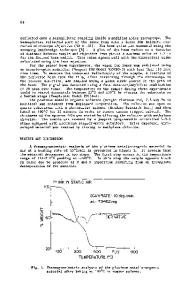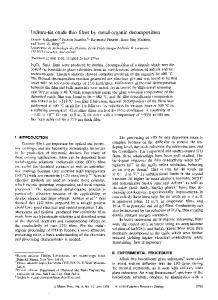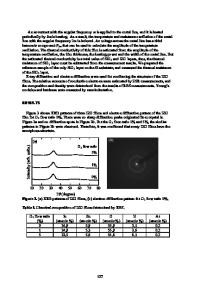Thermal decomposition and fractal properties of sputter-deposited platinum oxide thin films
- PDF / 553,679 Bytes
- 8 Pages / 584.957 x 782.986 pts Page_size
- 84 Downloads / 803 Views
id Horwatb) Institut Jean Lamour, Ecole des Mines de Nancy, 54042 Nancy, France
Luis Vazquez Instituto de Ciencia de Materiales de Madrid, Consejo Superior de Investigaciones Científicas, E-28049 Madrid, Spain
Alejandro Gutiérrez Departamento de Física Aplicada and Instituto Nicolás Cabrera, Universidad Autónoma de Madrid, E-28049 Madrid, Spain
Alexei Erko Helmholtz-Zentrum Berlin für Materialien und Energie GmbH, Elektronenspeicherring BESSY II, 12489 Berlin, Germany
André Andersb) Lawrence Berkeley National Laboratory, University of California, Berkeley, California 94720
Joakim Anderssonb) The Angstrom Laboratory, Uppsala University, S-75121 Uppsala, Sweden
Jose L. Endrinoa),b) Abengoa Research, Campus Palmas Altas, E-41014 Sevilla, Spain (Received 17 August 2011; accepted 21 October 2011)
Porous platinum thin films were prepared by thermal decomposition at temperatures from 25 to 675 °C of platinum oxide films deposited by a pulsed reactive sputtering technique. The samples’ chemistry and structure were investigated by x-ray diffraction (XRD), x-ray photoelectron spectroscopy (XPS), and x-ray absorption near edge structure (XANES), showing that the decomposition of the oxide begins as low as 400 °C and follows a sigmoidal trend with increasing annealing temperature. In the XRD spectra, only an amorphous-like signature was observed for temperatures below 575 °C, while Pt 4f XPS showed that the deposited oxide was a mixture of PtO2 and PtO. Pt-L3 edge XANES and Pt 4f XPS spectra showed that the Pt concentration and electronic structure are predominant for temperatures equal to or above 575 °C. The morphologies of the films were investigated by the area-perimeter method from atomic force microscopy and scanning electron microscopy (SEM) images, indicating that the surfaces exhibit a combination of Euclidian and fractal characteristics. Moreover, the thermal evolution of these characteristics indicates the agglomeration of the grains in the film as observed by SEM.
I. INTRODUCTION
Porous platinum thin films are of significant technological importance because they can be used as catalysts,1,2 electrodes,3 and as components of fuel cells and a)
Address all correspondence to this author. e-mail: [email protected] b) This author was an editor of this focus issue during the review and decision stage. For the JMR policy on review and publication of manuscripts authored by editors, please refer to http://www.mrs. org/jmr-editor-manuscripts/ DOI: 10.1557/jmr.2011.418 J. Mater. Res., Vol. 27, No. 5, Mar 14, 2012
http://journals.cambridge.org
Downloaded: 30 Sep 2014
sensors.4,5 Porous platinum oxide films could serve as precursors to achieve high specific surface area in platinum electrodes.6 The variety of porous platinum is recognized in three different states: platinized platinum, platinum sponge, and platinum black,7 allowing coatings with different characteristics. For instance, platinum black is a dispersed black powder with a specific surface area of 30–40 m2/g8 used for the fabrication of platinized e
Data Loading...









